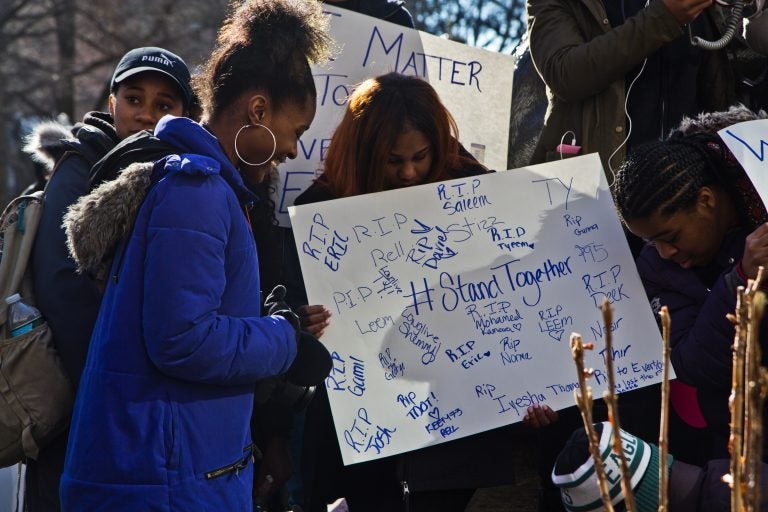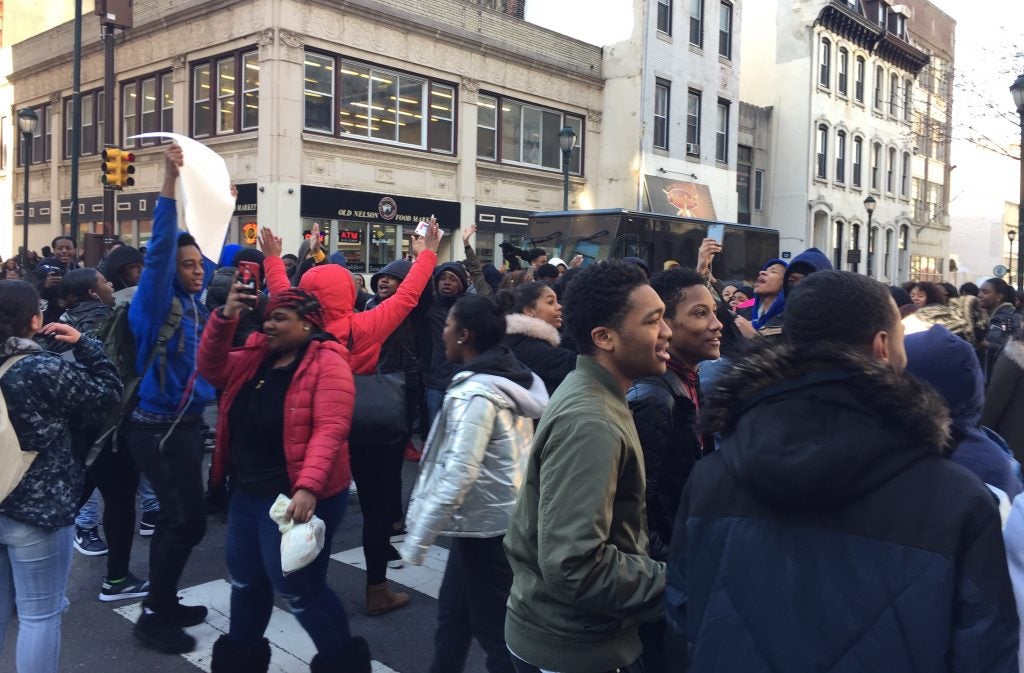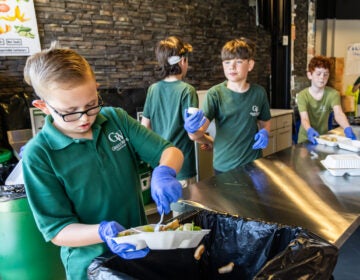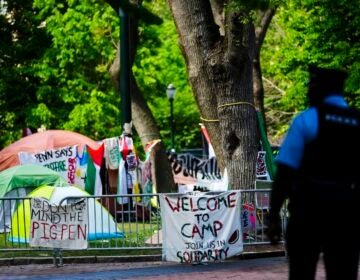‘We knew in our hearts we had to do it:’ Behind the scenes of one Philly school’s walkout
Wednesday’s protests were officially about gun control. But they were was as much about young people stretching their voices, finding their place in the world.
Listen 5:12
Dymonique Hammond and her classmates from Freire Charter High School during the National School Walkout on March 13, 2018. (Kimberly Paynter/WHYY)
Dymonique Hammond had something to say, but she wasn’t quite sure how to say it.
On Wednesday morning, as thousands of high school students across the country walked out of school to protest gun violence, Hammond and the rest of her classmates at Freire Charter High School in Center City, Philadelphia, gathered in Rittenhouse Square as part of a school-sanctioned rally. The plan was to observe a moment of silence and then have students chalk the sidewalks with names of friends and loved ones lost to gun violence.
Hammond had other ideas.
Midway through the activity, she mounted the lip of a fountain, grabbed a bullhorn, and turned to address the roughly 500 students and staff below.
One problem: The bullhorn wouldn’t cooperate.
For about three minutes, the high school junior and her friends fumbled with the device the way a more experienced activist (of the middle-aged persuasion, perhaps) might stagger through Snapchat. What went where? Which button did what?
Finally, the bullhorn sprang to life, and the group made an announcement.
“If y’all are participating, we wanna have a march to 15th Street, so that way we can spread the word a bit more,” Hammond said.
It didn’t appear most of the students heard her. Or if they did, they didn’t sound inspired.
She was proposing a small rebellion — an alternative march that would lead the students to City Hall and deviate from the script laid out by school leaders.
Hammond wasn’t typically the political type. But this issue and this walkout had grabbed her in a profound way.
She’d lost one of her best friends to a bullet in eighth grade. Too many of her classmates at Freire — where the vast majority of students are low-income and African-American — had similar stories to tell about a friend or an uncle or a cousin.
Earlier that week in English class, they’d talked about gun violence. The personal testimonies spilled out and pooled into a sort of collective resentment: Why, the students wondered, did it take a mass shooting at a suburban high school in Florida for people to care about gun violence in Philadelphia?
“In the black community, there are lot of people who are shot, and it’s like it becomes a norm, so nobody really cares about it,” Hammond said.
The chalk exercise had been an attempt by school leaders to swing the conversation from Parkland to Philadelphia. Still, it didn’t feel sufficient. Or maybe it just felt too controlled.
“Writing down chalk and names is not enough,” said junior Nafir Royal. “This is more than just names in a park.”
Hammond and her friends came up with a chant to express their frustration.
“We matter, too,” they yelled. “We’ve had enough.”
The question now was whether Freire students cared enough to heed Hammond’s call for a rogue march. In the moments right after the half-botched bullhorn announcement, the odds seemed slim.
Some of the students took the rally in Rittenhouse seriously, but just as many seemed to be sleepwalking through another school-organized exercise. They were teens in school, doing as they were told and doing it with a smirk.
“Get your chalk here,” yelled one of the students earlier that morning, sarcastically mimicking a carnival barker. “Come write your dead loved ones in the chalk!”
After Hammond’s announcement, the students began walking back to school, as instructed. Their path took them to the corner of 20th and Chestnut Streets.
A turn left would take them back to school. If they went straight toward Market Street they’d be on to City Hall. It was a crossroads between the protest they were supposed to have and the protest some of them wanted to have.
As the choice dangled before them, dozens of Freire students spontaneously flooded the downtown streets. Traffic halted, horns blared, and the students cheered, seemingly at the discovery of their own power.
The cheer fed more cheers, like a feedback loop of emerging confidence.
As the roar gathered strength, about 200 students — roughly half the student body — turned toward City Hall.

They were a jubilant bunch.
Some relished the freedom. Others seemed simply to be teenagers caught up in the eternal thrill of rule-breaking. But many of them sounded genuinely fired up about gun control, a cause that struggled to grab their attention just 15 minutes earlier.
This was now their march.
“We knew in our hearts we had to do it,” said junior Kevin Scott. “And I’m just glad that we did it together.”
At City Hall, the Freire students linked up with peers from other schools, and spent about 15 minutes chanting. Then they turned back to school.
“It wasn’t really a plan,” said junior Shakira Jackson. “I’m really just supporting the movement. I just feel as though things gotta change. And if people don’t wanna act on it, you gotta speak your dreams into existence.”
Wednesday’s protests were officially about gun control. But the story across the region was as much about young people stretching their voices, finding their place in the world, and confronting the possible consequences of their convictions.
“Teenage activism is our most vital weapon right now in our society,” said Royal, whose uncle, Timothy Goode, was killed by a police officer. “We went to 15th street to protest with the other students.”
The Freire students thought they’d be punished for their actions. For a time, that seemed like a possibility.
Administrators, fearing a student might get hurt or ditch school, frantically notified parents about the unsanctioned action. But when the protestors returned to class, school officials had decided against any discipline.
They noted it would have been insincere to suspend students for protesting when the school’s namesake, Paolo Freire, made his name with book titled “Pedagogy of the Oppressed.”
“What happened yesterday was completely in line with the mission of the school,” said head of school Nick Fels. “It was remarkable.”
When the protest was over, Dymonique Hammond stood in the school’s third-floor hallway, just outside the English class where, 24 hours earlier, she’d lamented the lack of attention paid to everyday gun violence. Classmates congratulated her as they passed.
“We got your back, Dom!”
The plan for the march to 15th Street had come together quickly, she said, over just a few days of informal planning.
“It was like a last-minute thought and I was like, ‘Oh my God, I’m not sure it is going to work,’ ” she said, jittering with joy. “And then today came. And it worked. And I’m so proud of myself.”
When the day started, she couldn’t figure out how to work the bullhorn. Now her voice seemed stronger, almost as if she didn’t need one anymore.
WHYY is your source for fact-based, in-depth journalism and information. As a nonprofit organization, we rely on financial support from readers like you. Please give today.





